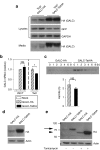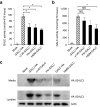HIV Tat Domain Improves Cross-correction of Human Galactocerebrosidase in a Gene- and Flanking Sequence-dependent Manner
- PMID: 24150577
- PMCID: PMC4027426
- DOI: 10.1038/mtna.2013.57
HIV Tat Domain Improves Cross-correction of Human Galactocerebrosidase in a Gene- and Flanking Sequence-dependent Manner
Abstract
Krabbe disease is a devastating neurodegenerative lysosomal storage disorder caused by a deficiency of β-galactocerebrosidase (GALC). Gene therapy is a promising therapeutic approach for Krabbe disease. As the human brain is large and it is difficult to achieve global gene transduction, the efficacy of cross-correction is a critical determinant of the outcome of gene therapy for this disease. We investigated whether HIV Tat protein transduction domain (PTD) can improve the cross-correction of GALC. Tat-PTD significantly increased (~6-fold) cross-correction of GALC through enhanced secretion and uptake in a cell-culture model system. The effects of Tat-PTD were gene and flanking amino acids dependent. Tat-fusion increased the secretion of α-galactosidase A (α-gal A), but this did not improve its cross-correction. Tat-fusion did not change either secretion or uptake of β-glucocerebrosidase (GC). Tat-PTD increased GALC protein synthesis, abolished reactivity of GC to the 8E4 antibody, and likely reduced mannose phosphorylation in all these lysosomal enzymes. This study demonstrated that Tat-PTD can be useful for increasing cross-correction efficiency of lysosomal enzymes. However, Tat-PTD is not a mere adhesive motif but possesses a variety of biological functions. Therefore, the potential beneficial effect of Tat-PTD should be assessed individually on each lysosomal enzyme.Molecular Therapy-Nucleic Acids (2013) 2, e130; doi:10.1038/mtna.2013.57; published online 22 October 2013.
Figures





Similar articles
-
Cellular uptake and lysosomal delivery of galactocerebrosidase tagged with the HIV Tat protein transduction domain.J Neurochem. 2008 Feb;104(4):1055-64. doi: 10.1111/j.1471-4159.2007.05030.x. Epub 2007 Nov 6. J Neurochem. 2008. PMID: 17986221
-
Genetic incorporation of the protein transduction domain of Tat into Ad5 fiber enhances gene transfer efficacy.Virol J. 2007 Oct 24;4:103. doi: 10.1186/1743-422X-4-103. Virol J. 2007. PMID: 17958897 Free PMC article.
-
Delivery of TAT/PTD-fused proteins/peptides to islets via pancreatic duct.Cell Transplant. 2005;14(5):241-8. doi: 10.3727/000000005783983016. Cell Transplant. 2005. PMID: 16052906
-
The taming of the cell penetrating domain of the HIV Tat: myths and realities.J Control Release. 2007 Feb 12;117(2):148-62. doi: 10.1016/j.jconrel.2006.10.031. Epub 2006 Nov 17. J Control Release. 2007. PMID: 17196289 Free PMC article. Review.
-
Intracellular transduction and potential of Tat PTD and its analogs: from basic drug delivery mechanism to application.Expert Opin Drug Deliv. 2012 Apr;9(4):457-72. doi: 10.1517/17425247.2012.663351. Expert Opin Drug Deliv. 2012. PMID: 22432469 Review.
Cited by
-
Krabbe Disease: Prospects of Finding a Cure Using AAV Gene Therapy.Front Med (Lausanne). 2021 Nov 11;8:760236. doi: 10.3389/fmed.2021.760236. eCollection 2021. Front Med (Lausanne). 2021. PMID: 34869463 Free PMC article. Review.
-
Biochemical, cell biological, pathological, and therapeutic aspects of Krabbe's disease.J Neurosci Res. 2016 Nov;94(11):990-1006. doi: 10.1002/jnr.23873. J Neurosci Res. 2016. PMID: 27638584 Free PMC article. Review.
-
Engineering Toxoplasma gondii secretion systems for intracellular delivery of multiple large therapeutic proteins to neurons.Nat Microbiol. 2024 Aug;9(8):2051-2072. doi: 10.1038/s41564-024-01750-6. Epub 2024 Jul 29. Nat Microbiol. 2024. PMID: 39075233 Free PMC article.
-
Brain-targeted enzyme-loaded nanoparticles: A breach through the blood-brain barrier for enzyme replacement therapy in Krabbe disease.Sci Adv. 2019 Nov 20;5(11):eaax7462. doi: 10.1126/sciadv.aax7462. eCollection 2019 Nov. Sci Adv. 2019. PMID: 31799395 Free PMC article.
References
-
- Wenger DA, Suzuki K, Suzuki Y, Suzuki K.2001Galactosylceramide lipidosis: globoid cell leukodystrophy (Krabbe disease). Scriver CR, Beaudet AL, Sly WS, Valle D.eds). The Metabolic and Molecular Bases of Inherited Disease8 edn. McGraw-Hill; New York; 3669–3694.
-
- Krivit W, Shapiro EG, Peters C, Wagner JE, Cornu G, Kurtzberg J, et al. Hematopoietic stem-cell transplantation in globoid-cell leukodystrophy. N Engl J Med. 1998;338:1119–1126. - PubMed
-
- Shen JS, Watabe K, Ohashi T, Eto Y. Intraventricular administration of recombinant adenovirus to neonatal twitcher mouse leads to clinicopathological improvements. Gene Ther. 2001;8:1081–1087. - PubMed
-
- Meng XL, Shen JS, Watabe K, Ohashi T, Eto Y. GALC transduction leads to morphological improvement of the twitcher oligodendrocytes in vivo. Mol Genet Metab. 2005;84:332–343. - PubMed
LinkOut - more resources
Full Text Sources
Other Literature Sources
Research Materials
Miscellaneous

